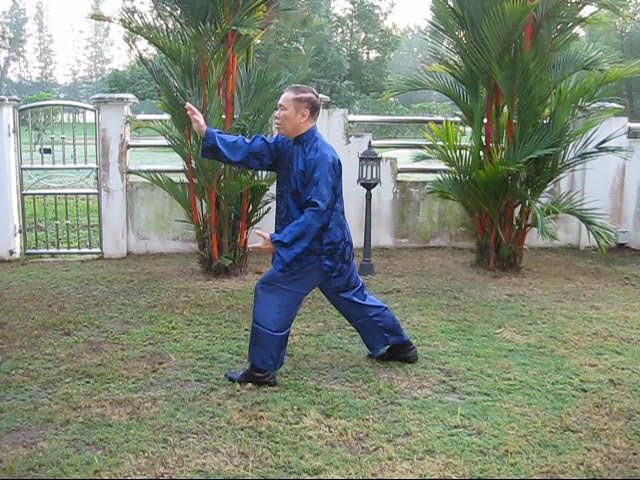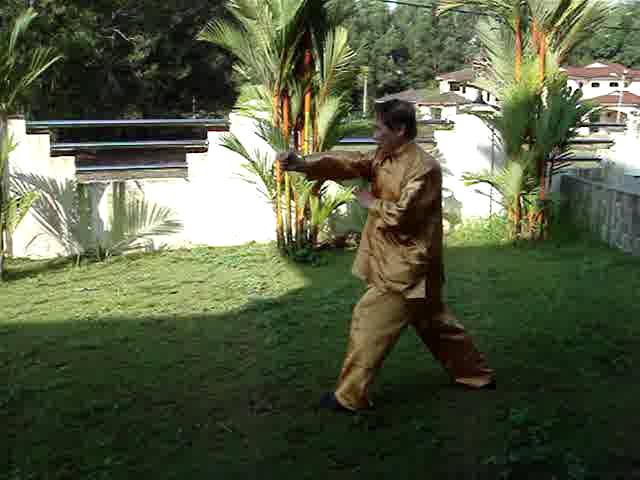CHAPTER 1 -- A HISTORICAL AND COMPARATIVE SURVEY OF KUNGFU

"Shooting Arrows", one of the exercises in the Eighteen Hand-Movements of the Lohans
Kungfu is the classical art of attack and defence, and is now practiced by people of different races and religions for health as well as for combative purposes. Wing Choon Kungfu is the style of kungfu that was founded by a charming lady, Yim Wing Choon.
Kungfu is very old; it is as old as mankind, for the earliest men must have some methods of attack and defence against other hostile men, or against wild animals. Even when men became civilized, fighting was not infrequent. Generals and warriors featured prominently in the early dynastic history of China. Kungfu at that time, however, was not institutionalized; it belonged to the individuals rather than to any well-defined institutions. A competent general might organize regular martial training for his soldiers, but the combative techniques taught were those of the individual instructors, and not of any institutionalized systems.
Shaolin Kungfu
The earliest known system or style of kungfu developed in the Shaolin Monastery, a Buddhist monastery built about 377 C.E. in the Henan Province of China. It was here for the first time in China, and possibly for the first time in the world, that martial arts were systematically studied and classified on an extensive scale. This system came to be known universally as Shaolin Kungfu, and was to have lasting impact on almost all styles of kungfu in China, and on many styles of martial arts of other countries.
Bodhidharma, or the Venerable Da Mo as he is popularly known in Chinese, is regarded as the First Patriarch of Shaolin Kungfu because he introduced kungfu to the Shaolin Monastery. Bodhidharma came from India to preach Buddhism, and arrived at the Shaolin Monastery about 527 C.E. There he stayed for nine years. When he noticed the monks at the monastery were weak and inattentive, he devised for them a system of exercises known as the "Eighteen Hand-Movements of the Lohans", or "Lo Hon Sap Pat Sau" in Cantonese Chinese, which became the fore-runner of Shaolin Kungfu. Later, secular disciples were accepted to learn kungfu at the monastery.
Because of systematic experimentation and classification, and because of the dedication and disciplined training of the Shaolin masters and disciples, the volume of Shaolin Kungfu grew rapidly. Soon it became too enormous and diversified for an individual to master all of it in one lifetime. Specialization, therefore, was necessary. Disciples were taught the type of kungfu that suited their nature and needs. By the Tang Dynasty (7th to 10th centuries), the Shaolin Monastery became the pinnacle of kungfu.

A Tai Chi Chuan pattern as evolved by Zhang San Feng
Emergence of Other Styles
During the Song Dynasty (10th to 13th centuries), a major style of kungfu evolved from the parental Shaolin Kungfu. Zhang San Feng (pronounced as /Chang San Foong/), a Taoist priest who spent his hermit days at the Wudang (pronounced as /Wu Tang/) Mountain after graduating from the Shaolin Monastery, founded a style of kungfu called Tai Chi Chuan. This style of kungfu emphasizes soft force, circular movements and breathing exercises, and is normally performed slowly and gracefully like a classical dance.
In the same dynasty, Yue Fei, another Shaolin disciple who was also a famous general, evolved another style of kungfu called Shing Yi Kungfu, or "Xingyiquan" in Romanced Chinese. Shing Yi Kungfu is "softer" than the parental Shaolin Kungfu, but "harder" than Tai Chi Chuan. Besides Shing Yi Kungfu, Yue Fei also founded Eagle-Claw Kungfu, a style that uses the hands like the claws of eagles for holding and locking techniques.
In the Yuan Dynasty (13th to 14th centuries) a kungfu expert called Pai Yi Foong gathered together Shaolin masters of different specialization, and evolved a new style of kungfu called Wu Chu Kungfu, or Wuzuquan in Romanized Chinese. "Wu Chu" mean "Five Ancestors", named after the five masters who individually specialized in the Da Mo Style, the White Crane Style, the Lohan Style, the Monkey Style and the First Emperor Style. The First Emperor Style, known as Tai Chu Chuan in Chinese, is named after the first emperor of the Song Dynasty, Chao Kwang Yin, who was himself an accomplished Shaolin disciple.
In the subsequent Ming Dynasty (14th to 17th centuries), another style of kungfu, Praying Mantis Kungfu, developed from the parental Shaolin. Praying Mantis Kungfu was founded by Wang Lang, who adopted the long hand movements of the praying mantis, and the agile footwork of the monkey. Later, many sub-styles of Praying Mantis Kungfu developed, such as Shang-Tung Praying Mantis, Seven-Star Praying Mantis, and Plum-Flower Praying Mantis. There is also another style called Southern Praying Mantis, but this style did not develop from Praying Mantis Kungfu, which is a northern style.
Meanwhile, specialization at the Shaolin Monastery also encouraged crystallization and evolution of distinct styles. After graduating from the monastery, Shaolin masters taught Shaolin Kungfu all over the country. In their teaching, these masters would have, consciously or unconsciously, emphasized the particular styles or aspects of Shaolin Kungfu they themselves specialized in. As time went on, the differences between the various Shaolin aspects became accentuated and distinct styles evolved. Some of the well-known styles that resulted were the Lohan Style, the Monkey Style, the Floor Style, the Tantui Style and the Phat-Kua Style. These styles, incidentally, are sometimes known as northern styles, because they are generally popular in North China, north of the Yangtze Kiang with the Shaolin Monastery at Henan as the centrifugal nucleus.

The Monkey Style evolved from the parental Shaolin Kungfu
Southern Shaolin
The Qing Dynasty (17th to 19th centuries) witnessed further an extensive division of Shaolin styles, especially in South China. These styles, therefore, are sometimes known as southern styles. To a great extent, this division was an outcome of the Manchurian army attacking and burning the Shaolin Monastery, first in Henan and later in Fujian where another Shaolin Monastery was built, because the Shaolin Monastery had become an inspiration to revolutionaries against Manchurian rule. Many Shaolin masters escaped to Kwangtung (or Gauangdong in Romanized Chinese), a southern, coastal province of China. In order to avoid the attention of the Manchurian government, Shaolin masters used different names to designate the Shaolin Kungfu they taught.
One popular way was to name the particular style of kungfu after the instructor who taught it, or after the grand-master of the instructor himself. Another frequently used method was to name after the specific emphasis or form of application of that particular style. For example, if the instructor was called Chu, then the style of kungfu he taught was often named the Kungfu of the Chu Family, or Chu Ka Kungfu -- "ka" meaning "family" in Chinese. If the crane was an important feature of the style, this style of kungfu would be called White Crane Kungfu.
The five Shaolin grand-masters of this period were Shaolin nun Ng Mui (pronounced as "Wu Mei" in Mandarin Chinese), Taoist priest Pak Mei ("Bai Mei" in Mandarin and meaning "White Eye-Brow"), the Venerable Chee Seen ("Zhi Shan" in Mandarin), Taoist priest Foong Tou Tak ("Feng Dao Te" in Mandarin), and layperson Miu Hein ("Miao Xian" in Mandarin). Ng Mui Kungfu and Pak Mei Kungfu, therefore, were named after the two senior grand-masters.
After the burning of the Shaolin Monastery in Henan, the Venerable Chee Seen (which means "Extreme Kindness" in Chinese) rebuilt the Shaolin Monastery in Fujian Province in South China. (The Shaolin Monastery built by the Venerable Chee Seen was after the burning of the Shaolin Monastery in Henan by warlords using modern firearms. Many people may not know this fact. There were two Shaolin monasteries in Fujian Province, one in Quanzhou and the other in Jiulianshan. The Shaolin Monastery above refers to the one in Quanzhou.) Chee Seen was the Abbot and the Chief Kungfu Instructor of this southern Shaolin Monastery which became the radiating centre for southern styles. Many Shaolin masters who later spread Shaolin Kungfu in South China were his disciples. The Venerable Chee Seen, therefore, is regarded as the First Patriarch of Southern Shaolin Kungfu.
Foong Tou Tak retreated to the Wudang (pronounced as /Wu Tang/) Mountain. The style of kungfu after him is sometimes referred to as Wudang Shaolin. This style is different from the Wudang Kungfu of Zhang San Feng (pronounced as /Chang San Foong/ in English). Miu Hein specialized in the Flower Style of Shaolin Kungfu, thus his style is often known as Flower Kungfu. Because of bitter differences, Pak Mei and Foong Tou Tak later broke off from Shaolin and became the antagonists of Chee Seen.

Hoong Ka Kungfu is famous for its forceful punch
In Kwangtung ("Guangdong" in Romanized Chinese), a stronghold in the division and spread of Shaolin Kungfu, there were five major styles named after the surnames of five masters -- Hoong, Lau, Choy, Li and Mok. Being all derived from Southern Shaolin, these five styles are basically similar, but differ in detail, specific emphasis and application.
Of these five, Hoong Ka Kungfu (Kungfu of the Hoong Family) is the most famous. It is named after Hoong Hei Khoon ("Hong Xi Guan" in Mandarin Chinese), a distinguished kungfu master who had learnt from the Venerable Chee Seen at the Shaolin Monastery in Fujian. Hoong Ka Kungfu is renowned for its stable horse stance, powerful arms and forceful punches.
On the other hand, Lau Ka Kungfu, named after Lau Sam Gnan, is noted for its staff techniques; while Choy Ka Kungfu, named after Choy Pak Tat, is noted for its agility and leg techniques, especially its sweeping kick. Li Ka Kungfu is named after Li Pa San, a disciple of Pak Mei. It is noted for its phoenix-eye punch. Mok Ka Kungfu is named after Mok Cheng Kiu. Because "Cheng Kiu" is normally a girl's name, according to a grand-master of Mok Ka Kungfu many people mistakenly thought that Mok Cheng Kiu was a lady. Mok Ka Kungfu is famous for its kicks, especially the cockerel kick and the back-thrust kick.
Another popular southern style is Choy-Li-Fatt (pronunced as /Chai-Li-For/ in Mandarin) Kungfu. It was found by a revolutionary named Chan Harng, who incorporated Choy Ka Kungfu, Li Ka Kungfu and Fatt Ka Kungfu. "Fatt" means "Buddha", thus Fatt Ka Kungfu means the Kungfu of the Buddhist Family.
Instead of naming the style of kungfu after the master or grand-master who started or propagated it, some named the style after the animal-form or significance that particular style emphasizes. There are five major animal-forms in Shaolin Kungfu, namely dragon, snake, tiger, leopard and crane. The style that emphasizes specially on the dragon form, for example, is called Dragon-Style Kungfu. This Dragon-Style Kungfu is closely related, and therefore similar in many aspects, to Pak Mei Kungfu.
White Crane Kungfu is another important style. One of this important style which makes use of the long arm movements which resemble the wings of the crane is also known as Lama Kungfu, as it was taught by Tibetan Lama monks, or as Hap Ka Kungfu, as it was later propagated by instructors who believed in the chivalrous traditions of the Chinese classical knights, pronounced as "hap" in the Cantonese dialect.
Grandmaster Wong Kiew Kit,
15th July 2019.

The leopard punch is popular in Choy-Li-
Fatt Kungfu
LINKS
Introduction to Wing Choon Kungfu
Courses and Classes





